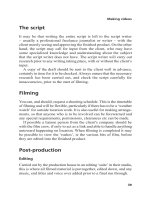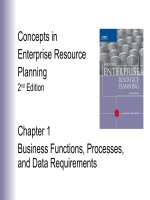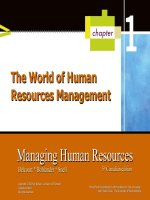Lecture Project management in practice (Fifth Edition) – Chapter 1: The world of project management
Bạn đang xem bản rút gọn của tài liệu. Xem và tải ngay bản đầy đủ của tài liệu tại đây (600.86 KB, 38 trang )
Project Management in Practice
Fifth Edition
Chapter 1
The World of Project
Management
Copyright © 2014 John Wiley & Sons, Inc.
11
Why the Emphasis on Project
Management?
•
•
Many tasks do not fit neatly into business
asusual
Organizations need to assign responsibility
and authority for the achievement of their
goals
12
Characteristics of Projects
•
•
•
Unique
Specific deliverables
Specific due date
13
Formal Definition of a Project
“A project is a temporary endeavor
undertaken to create a unique product or
service.”
Project Management Institute, 2007
14
Formal Definition of Project
Management
“The application of knowledge, skills, tools,
and techniques to a broad range of activities
in order to meet the requirements of a
particular project.”
Project Management Institute, 2007
15
Other Common Characteristics of
Projects
•
•
•
•
Multidisciplinary
Complex
Often involve conflicts
Part of programs
16
Trends in Project Management
•
•
•
•
•
Achieving strategic goals
Achieving routine goals
Improving project effectiveness
Virtual projects
Quasiprojects
17
Comparison of Project Management
and General Management
Table 11
18
Project Budgets
•
•
•
Project budgeting differs from standard budgeting
in the way budgets are constructed
Budgets for nonprojects are primarily
modifications of budgets for the same activity in
the previous period
Project budgets are newly created for each project
and often cover several “budget periods” in the
future
19
Project Schedules
•
In manufacturing, the sequence of activities
is set when production line designed
–
•
Sequence is not altered when new models are
produced
Each project has a schedule of its own
–
–
Previous projects with deliverables similar to
current one may provide a rough template
However, specifics unique to project at hand
110
Project Organizational Structure
•
Routine work of organizations takes place within a
welldefined structure
–
•
•
The divisions, departments, sections, and similar
subdivisions of the total unit
Typical project cannot thrive in this structure
The need for technical knowledge, information,
and special skills requires that departmental lines
be crossed
–
Another way of describing the multidisciplinary
character of projects
111
Globalization
•
•
•
•
When large firms establish manufacturing plants
or distribution centers in different countries, a
management team is established on site
For projects, globalization has a different meaning
Members of project teams may be spread across
countries and speak different languages
Some project team members may never have a
facetoface meeting
112
Negotiation
•
•
•
With little authority, the project manager
depends on negotiation skills to gain the
cooperation of departments in the
organization
Those departments have their own
objectives, priorities, and personnel
The project is not their responsibility and
the project tends to get the leftovers
113
Three Different Types of
Negotiation
1.
2.
3.
Winwin
Winlose
Loselose
114
Three Goals of Project Management
1.
2.
3.
Scope
Cost
Time
115
Scope, Cost, and Time
Project Performance Targets
Figure 11
116
Uncertainty
•
All projects are always carried out under
conditions of uncertainty
–
•
•
Projects are all about uncertainty
Effective project management requires an ability
to deal with uncertainty
Projects are complex and include interfaces,
interdependencies, and assumptions, which may
turn out to be wrong
–
People add to the uncertainty
117
Uncertainties Encountered in Project
Management
•
•
•
•
•
•
Time required to complete a project
Availability and cost of key resources
Timing of solutions to technological
problems
Macroeconomic variables
The whims of clients
Actions taken by competitors
118
Can Uncertainty be Eliminated?
•
•
No, uncertainty cannot be eliminated
However, if managed properly, it can be
minimized
119
Managing Risk
•
The first step in managing risk is to identify
potentially uncertain events and likelihood of
occurrence
–
•
•
Called risk analysis
Different organizations approach this differently
The essence of risk analysis is to make
assumptions about key risk parameters and to use
models to evaluate the desirability of certain
managerial decisions
120
Fourth Project Goal
•
•
•
There is a relationship between uncertainty
and the three traditional project goals
Therefore, we adopt the view in this book
that managing uncertainty is a fourth goal
of project management
Thus, the primary role of the project
manager is to effectively manage the trade
offs between cost, time, scope, and risk
121
Abilities Needed For Effective
Project Management
•
•
•
•
•
Ability to resolve conflicts
Creativity and flexibility
Ability to adjust to change
Good planning skills
Negotiation skills
122
The Life Cycle of Projects
•
All organisms have a life cycle, they are born,
grow, wane, and die
–
•
Some projects follow an Sshaped curve
–
•
So do projects
They start slowly, develop momentum, and then finish
slowly
Other project follow a Jshaped curve
–
They start slowly , proceed slowly, and then finish
rapidly
123
The Project Life Cycle
Figure 12
124
An Alternate Project Life Cycle
Figure 13
125









